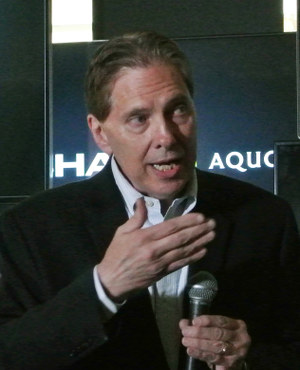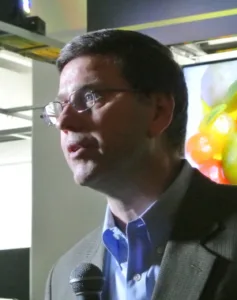Yesterday (June 10) at a Lower West Side exhibit space in New York, Sharp showed media people its line-up of Aquos UHD-TVs now hitting retailer’s floors and websites in the US.

Sets were exhibited in five mini-areas, each focused on one of the five themes Sharp was highlighting:
- Aquos 4k Ultra HD
- AquoDimming
- 4k UHD Streaming
- Android TV
- Spectros wide color gamut
Netflix and Google staffers were on hand to help explain the streaming and Android TV parts.
Jim Sanduski, Sharp – Photo:Ken WernerBut before he got to the hardware, Jim Sanduski (President of Sharp Electronics Marketing Company of America) led off with comments on the negative reporting on Sharp “you might have seen in the press”. The situation is nowhere nearly as dire as portrayed, said Sanduski. “Sharp has secured additional operating bank funding, and we will show a profit for the full fiscal year”, and “We have no intention of retreating from the US market”.
In explaining this show’s exclusive focus on UHD, Sanduski said, “To say 4k has arrived is an understatement”. By the end of this year, he continued, “We will have sold over 4 million 4k televisions”.
Most of the sets shown yesterday were also shown at CES, but it is customary for US set makers to have such a “line show” when the sets are actually becoming available to consumers, and design details and MSRPs are final. The Aquos 4k line-up consists of nine sets in seven screen sizes ranging from 32″ to 80″, and prices ranging from $599 (estimated street price) for a 43″ to $5000 (estimated street price) for an 80″.
Think about that for a moment. Six hundred dollars for a 4k TV from a major brand. That would have been almost unthinkable two years ago, and it may explain why there is no Q+ UHD set in the line-up now, although one is planned for Q1’16, Sanduski told me. To refresh memories, Q+ is Sharp’s truly brilliant technique for creating an almost-UHD experience from a set using a four-primary FHD panel. The problem with Q+ (formerly Quattron+) is that full UHD has became so inexpensive so fast that the Q+ opportunity window closed almost as soon as it opened.
Much the same seems true for Quattron, the four-primary screen design for expanding color gamut. Although Quattron has had a longer run, the success of quantum-dot enhanced color (and related techniques) is closing that window, too. There is only one Quattron set in the line-up, Sanduski told me, and that is FHD, not UHD.
After Sanduski’s introductory comments, he introduced old industry hand Peter Weedfald, who became SVP of Sharp’s American sales three weeks ago. In his usual punchy style, Weedfald said, “We’re in an upgrade and replacement business”.
Why is Sharp focusing so heavily on smart TVs? “Sixty percent of TVs on the retail floor are smart”.
 Peter Weedfald, Sharp – Photo: Ken WernerWeedfald tried to make it easy to understand the three series in the Aquos line-up.
Peter Weedfald, Sharp – Photo: Ken WernerWeedfald tried to make it easy to understand the three series in the Aquos line-up.
- The UB line is entry level.
- The intermediate UE line has 60″, 70″ and 80″ sets and has Android TV and AquoDimming
- The premium UH line has 70″ and 80″ sets, and adds the company’s Spectros technology for a 21% wider color gamut. The 70″ UH is the only current Sharp set that has earned THX certification extremely accurate image reproduction.
If you want Spectros in a 60″ set, you’re out of luck.
In his introductory remarks, Sanduski said — as Sharp reps carefully said at CES 2015 — that the Spectros Rich Color Display is “somewhat similar to what quantum dots deliver in the marketplace.” I had to speak with both Sanduski and a PR person on the show floor who had recently spoken with Sharp engineers to get sense of what Spectros is. Sanduski preferred to speak in generalities, but when I suggested the approach used phosphors on a sheet in front of the backlight, similar to QDEF, he firmly corrected me and said that there was no sheet. The PR guy added that red and green phosphors are placed directly on the blue LEDs to create RGB white light, and this is done both for edge-lit and direct-lit models. (Effectively, RG LEDs are white LEDs but use separate phosphors, rather than the yellow ‘YAG’ phosphor used in previous generations of white LED which have less well defined primaries – Man. Ed)
Why not use quantum-dot enhancement now? “Quanturm dots are still expensive”, said Sanduski,” but we’re certainly looking at them for the future”.
Sharp, I was told, is one of only two brands to offer Google TV in the US. The Android TVs will have “600 apps by this fall in the Google Play Store”, can be controlled by your Android phone and can have the content on other Android devices Bluetoothed to them. These sets have 16GB of memory and a quad-core processor
Sharp’s Chris Ford said that AquoDimming, Sharp’s version of local dimming, is “pixel level dimming”. I’m not sure what this means, but it sounds like each LED in the direct backlight is controlled individually and therefore constitutes its own local-area zone. (I have yet to understand how this constitutes “pixel-level dimming”, but all things come to he who waits.) – Ken Werner

